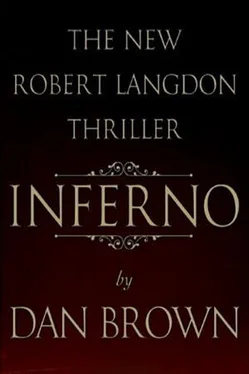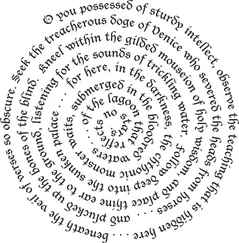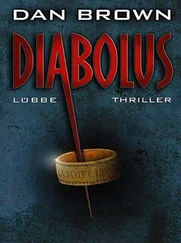The tip of the pointer in his hand was now glowing intensely, and Langdon gave Sienna an uneasy grin. “Showtime.”
He aimed the bone-sheathed pointer at a bare space on the kitchen wall. When the wall lit up, Sienna drew a startled breath. It was Langdon, however, who physically recoiled in surprise.
The light that appeared on the wall was not a little red laser dot. It was a vivid, high-definition photograph that emanated from the tube as if from an old-fashioned slide projector.
My God! Langdon’s hand trembled slightly as he absorbed the macabre scene projected on the wall before him. No wonder I’ve been seeing images of death.
At his side, Sienna covered her mouth and took a tentative step forward, clearly entranced by what she was seeing.
The scene projected out of the carved bone was a grim oil painting of human suffering — thousands of souls undergoing wretched tortures in various levels of hell. The underworld was portrayed as a cutaway cross section of the earth into which plunged a cavernous funnel-shaped pit of unfathomable depth. This pit of hell was divided into descending terraces of increasing misery, each level populated by tormented sinners of every kind.
Langdon recognized the image at once.
The masterpiece before him— La Mappa dell’Inferno —had been painted by one of the true giants of the Italian Renaissance, Sandro Botticelli. An elaborate blueprint of the underworld, The Map of Hell was one of the most frightening visions of the afterlife ever created. Dark, grim, and terrifying, the painting stopped people in their tracks even today. Unlike his vibrant and colorful Primavera or Birth of Venus , Botticelli had crafted his Map of Hell with a depressing palate of reds, sepias, and browns.
Langdon’s crashing headache had suddenly returned, and yet for the first time since waking up in a strange hospital, he felt a piece of the puzzle tumble into place. His grim hallucinations obviously had been stirred by seeing this famous painting.
I must have been studying Botticelli’s Map of Hell , he thought, although he had no recollection of why.
While the image itself was disturbing, it was the painting’s provenance that was now causing Langdon an increasing disquiet. Langdon was well aware that the inspiration for this foreboding masterpiece had originated not in the mind of Botticelli himself … but rather in the mind of someone who had lived two hundred years before him.
One great work of art inspired by another.
Botticelli’s Map of Hell was in fact a tribute to a fourteenth-century work of literature that had become one of history’s most celebrated writings … a notoriously macabre vision of hell that resonated to this day.
Dante’s Inferno.
* * *
Across the street, Vayentha quietly climbed a service staircase and concealed herself on the rooftop terrace of the sleepy little Pensione la Fiorentina. Langdon had provided a nonexistent room number and a fake meeting place to his consulate contact — a “mirrored meet,” as it was called in her business — a common tradecraft technique that would enable him to assess the situation before revealing his own location. Invariably, the fake or “mirrored” location was selected because it lay in perfect view of his actual location.
Vayentha found a concealed vantage point on the rooftop from which she had a bird’s-eye view of the entire area. Slowly, she let her eyes climb the apartment building across the street.
Your move, Mr. Langdon.
* * *
At that moment, on board The Mendacium , the provost stepped out onto the mahogany deck and inhaled deeply, savoring the salty air of the Adriatic. This vessel had been his home for years, and yet now, the series of events transpiring in Florence threatened to destroy everything he had built.
His field agent Vayentha had put everything at risk, and while she would face an inquiry when this mission was over, right now the provost still needed her.
She damned well better regain control of this mess.
Brisk footsteps approached behind him, and the provost turned to see one of his female analysts arriving at a jog.
“Sir?” the analyst said, breathless. “We have new information.” Her voice cut the morning air with a rare intensity. “It appears Robert Langdon just accessed his Harvard e-mail account from an unmasked IP address.” She paused, locking eyes with the provost. “Langdon’s precise location is now traceable.”
The provost was stunned that anyone could be so foolish. This changes everything. He steepled his hands and stared out at the coastline, considering the implications. “Do we know the status of the SRS team?”
“Yes, sir. Less than two miles away from Langdon’s position.”
The provost needed only a moment to make the decision.
“L’Inferno Di Dante” , Sienna whispered, her expression rapt as she inched closer to the stark image of the underworld now projected on her kitchen wall.
Dante’s vision of hell , Langdon thought, rendered here in living color .
Exalted as one of the preeminent works of world literature, the Inferno was the first of three books that made up Dante Alighieri’s Divine Comedy —a 14,233-line epic poem describing Dante’s brutal descent into the underworld, journey through purgatory, and eventual arrival in paradise. Of the Comedy ’s three sections— Inferno, Purgatorio , and Paradiso — Inferno was by far the most widely read and memorable.
Composed by Dante Alighieri in the early 1300s, Inferno had quite literally redefined medieval perceptions of damnation. Never before had the concept of hell captivated the masses in such an entertaining way. Overnight, Dante’s work solidified the abstract concept of hell into a clear and terrifying vision — visceral, palpable, and unforgettable. Not surprisingly, following the poem’s release, the Catholic Church enjoyed an enormous uptick in attendance from terrified sinners looking to avoid Dante’s updated version of the underworld.
Depicted here by Botticelli, Dante’s horrific vision of hell was constructed as a subterranean funnel of suffering — a wretched underground landscape of fire, brimstone, sewage, monsters, and Satan himself waiting at its core. The pit was constructed in nine distinct levels, the Nine Rings of Hell, into which sinners were cast in accordance with the depth of their sin. Near the top, the lustful or “carnal malefactors” were blown about by an eternal windstorm, a symbol of their inability to control their desire. Beneath them the gluttons were forced to lie facedown in a vile slush of sewage, their mouths filled with the product of their excess. Deeper still, the heretics were trapped in flaming coffins, damned to eternal fire. And so it went … getting worse and worse the deeper one descended.
In the seven centuries since its publication, Dante’s enduring vision of hell had inspired tributes, translations, and variations by some of history’s greatest creative minds. Longfellow, Chaucer, Marx, Milton, Balzac, Borges, and even several popes had all written pieces based on Dante’s Inferno . Monteverdi, Liszt, Wagner, Tchaikovsky, and Puccini composed pieces based on Dante’s work, as had one of Langdon’s favorite living recording artists — Loreena McKennitt. Even the modern world of video games and iPad apps had no shortage of Dante-related offerings.
Langdon, eager to share with his students the vibrant symbolic richness of Dante’s vision, sometimes taught a course on the recurring imagery found in both Dante and the works he had inspired over the centuries.
Читать дальше
Конец ознакомительного отрывка
Купить книгу










